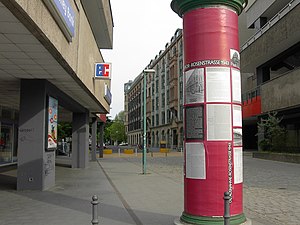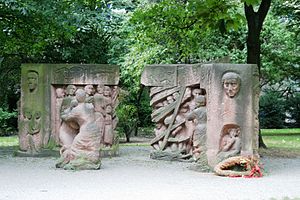Rosenstrasse protest
This article includes a list of references, related reading, or external links, but its sources remain unclear because it lacks inline citations. (February 2014) |

The Rosenstrasse protest was a nonviolent protest in Rosenstraße ("Rose street") in Berlin in February and March 1943, carried out by the non-Jewish ("Aryan") wives and relatives of Jewish men who had been arrested for deportation. The protests escalated until the men were released. It was a significant instance of opposition to the events of the Holocaust.
Events
Just after the German defeat in the Battle of Stalingrad, the Gestapo had arrested the last of the Jews in Berlin during the Fabrikaktion. Around 1,800 Jewish men, almost all of them married to non-Jewish women (others being the so-called Geltungsjuden), were separated from the other 6,000 of the arrested, and housed temporarily at Rosenstraße 2–4, a welfare office for the Jewish community located in central Berlin.
The 1,800 men were so-called "privileged Jews", a category exempt from deportation and other anti-Jewish measures by reason of being married to German spouses or employment as officials of the Reichsvereinigung der Juden in Deutschland, the Jewish organisation officially recognised by the German government for the purpose of controlling the Jewish population.
Remembrance

The building on Rosenstraße, near Alexanderplatz, in which the men were held, was destroyed during an Allied bombing of Berlin at the end of the war. The original Rosenstraße location is now marked by a rose colored Litfaß column 2–3 meters high, dedicated to the demonstration. Information about this event is posted on the Litfaß column.
In the mid-1980s, Ingeborg Hunzinger, an East German sculptor, created a memorial to those women who took part in the Rosenstraße Protest. The memorial, named "Block der Frauen" (Block of Women), was erected in 1995 in a park not far from the site of the protest. The sculpture shows protesting and mourning women, and an inscription on the back reads: "The strength of civil disobedience, the vigor of love overcomes the violence of dictatorship; Give us our men back; Women were standing here, defeating death; Jewish men were free."
The events of the Rosenstraße protests were made into a film in 2003 by Margarethe von Trotta under the title Rosenstraße.
References
- Nathan Stoltzfus, Resistance of the Heart: Intermarriage and the Rosenstrasse Protest in Nazi Germany, Rutgers University Press (March 2001) ISBN 0-8135-2909-3 (paperback: 386 pages)
External links
- The Women's Rosenstraße Protest in Nazi Berlin, Nathan Stoltzfus
- Resistance by Berlin women against Goebbels (German language)
- Encyclopedia of Jewish Suffering, Book review of Jews in Nazi Berlin: From Kristallnacht to Liberation. Edited by Beate Meyer, Hermann Simon and Chana Schuetz, The University of Chicago Press. Book review By Alexander Zvielli, The Jerusalem Post, 4/9/2010. "An evocative profile of wartime Berlin reveals the shame, humiliation and destruction that befell the city's Jews."
